International Financial Management Report: Ben & Jerry Analysis
VerifiedAdded on 2022/12/16
|19
|6148
|86
Report
AI Summary
This report provides a comprehensive analysis of Ben & Jerry's international financial management, examining its mission statement, its three dimensions (product, economic, and social), and assessing its performance across these dimensions. The report evaluates the company's product offerings, economic objectives, and social responsibility initiatives, providing ratings and supporting evidence from financial and non-financial data. It explores the factors that led to Ben & Jerry's takeover by Unilever, focusing on shareholder value and the company's financial underperformance relative to industry standards. The report also includes an evaluation of wealth maximization, stakeholder interests, and potential conflicts arising from company policies. The report also includes a discussion of potential conflicting responses, providing detailed insights into the financial aspects and strategic decisions that shaped Ben & Jerry's business operations. This report is contributed by a student to be published on the website Desklib.
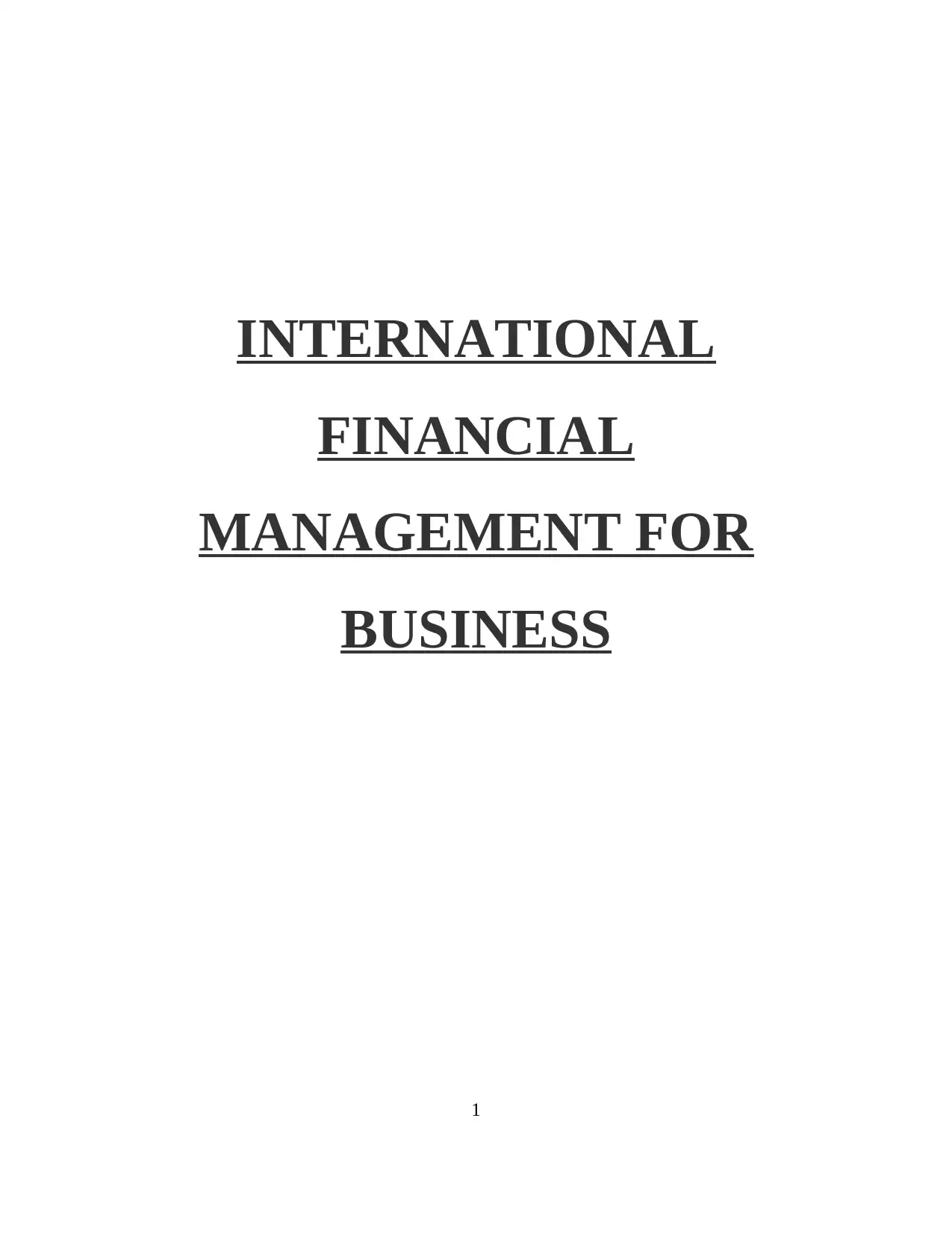
INTERNATIONAL
FINANCIAL
MANAGEMENT FOR
BUSINESS
1
FINANCIAL
MANAGEMENT FOR
BUSINESS
1
Paraphrase This Document
Need a fresh take? Get an instant paraphrase of this document with our AI Paraphraser

2
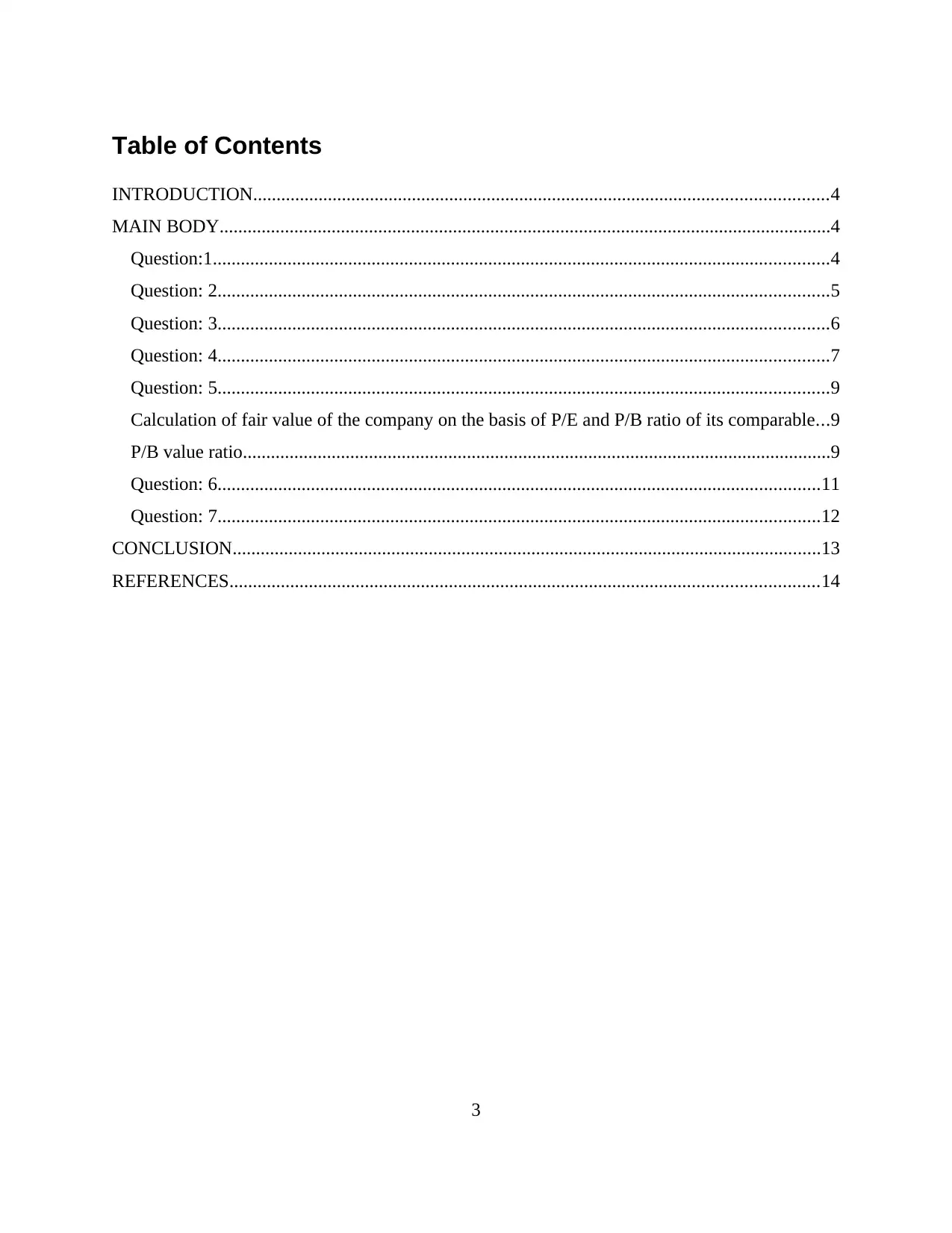
Table of Contents
INTRODUCTION...........................................................................................................................4
MAIN BODY...................................................................................................................................4
Question:1....................................................................................................................................4
Question: 2...................................................................................................................................5
Question: 3...................................................................................................................................6
Question: 4...................................................................................................................................7
Question: 5...................................................................................................................................9
Calculation of fair value of the company on the basis of P/E and P/B ratio of its comparable...9
P/B value ratio..............................................................................................................................9
Question: 6.................................................................................................................................11
Question: 7.................................................................................................................................12
CONCLUSION..............................................................................................................................13
REFERENCES..............................................................................................................................14
3
INTRODUCTION...........................................................................................................................4
MAIN BODY...................................................................................................................................4
Question:1....................................................................................................................................4
Question: 2...................................................................................................................................5
Question: 3...................................................................................................................................6
Question: 4...................................................................................................................................7
Question: 5...................................................................................................................................9
Calculation of fair value of the company on the basis of P/E and P/B ratio of its comparable...9
P/B value ratio..............................................................................................................................9
Question: 6.................................................................................................................................11
Question: 7.................................................................................................................................12
CONCLUSION..............................................................................................................................13
REFERENCES..............................................................................................................................14
3
⊘ This is a preview!⊘
Do you want full access?
Subscribe today to unlock all pages.

Trusted by 1+ million students worldwide
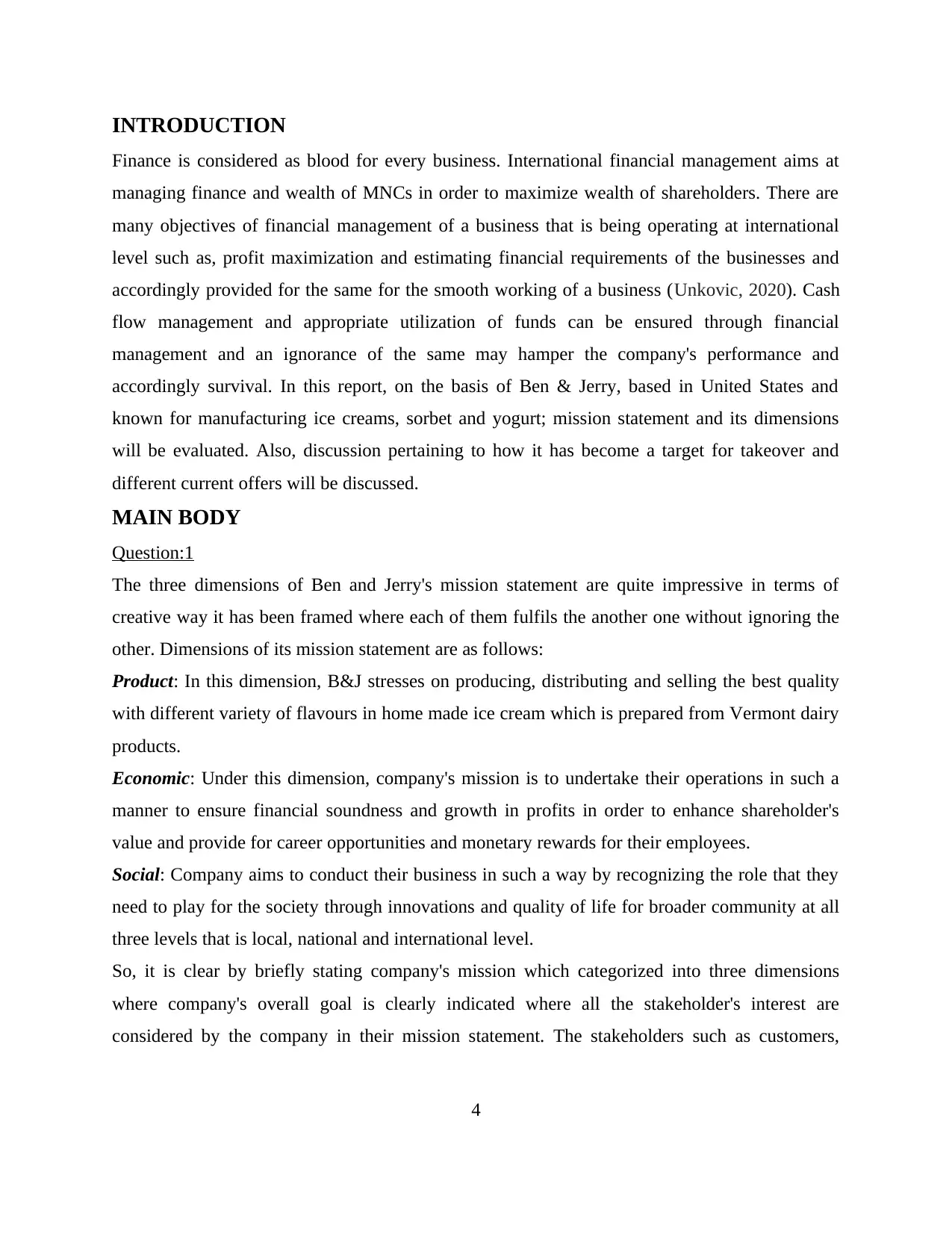
INTRODUCTION
Finance is considered as blood for every business. International financial management aims at
managing finance and wealth of MNCs in order to maximize wealth of shareholders. There are
many objectives of financial management of a business that is being operating at international
level such as, profit maximization and estimating financial requirements of the businesses and
accordingly provided for the same for the smooth working of a business (Unkovic, 2020). Cash
flow management and appropriate utilization of funds can be ensured through financial
management and an ignorance of the same may hamper the company's performance and
accordingly survival. In this report, on the basis of Ben & Jerry, based in United States and
known for manufacturing ice creams, sorbet and yogurt; mission statement and its dimensions
will be evaluated. Also, discussion pertaining to how it has become a target for takeover and
different current offers will be discussed.
MAIN BODY
Question:1
The three dimensions of Ben and Jerry's mission statement are quite impressive in terms of
creative way it has been framed where each of them fulfils the another one without ignoring the
other. Dimensions of its mission statement are as follows:
Product: In this dimension, B&J stresses on producing, distributing and selling the best quality
with different variety of flavours in home made ice cream which is prepared from Vermont dairy
products.
Economic: Under this dimension, company's mission is to undertake their operations in such a
manner to ensure financial soundness and growth in profits in order to enhance shareholder's
value and provide for career opportunities and monetary rewards for their employees.
Social: Company aims to conduct their business in such a way by recognizing the role that they
need to play for the society through innovations and quality of life for broader community at all
three levels that is local, national and international level.
So, it is clear by briefly stating company's mission which categorized into three dimensions
where company's overall goal is clearly indicated where all the stakeholder's interest are
considered by the company in their mission statement. The stakeholders such as customers,
4
Finance is considered as blood for every business. International financial management aims at
managing finance and wealth of MNCs in order to maximize wealth of shareholders. There are
many objectives of financial management of a business that is being operating at international
level such as, profit maximization and estimating financial requirements of the businesses and
accordingly provided for the same for the smooth working of a business (Unkovic, 2020). Cash
flow management and appropriate utilization of funds can be ensured through financial
management and an ignorance of the same may hamper the company's performance and
accordingly survival. In this report, on the basis of Ben & Jerry, based in United States and
known for manufacturing ice creams, sorbet and yogurt; mission statement and its dimensions
will be evaluated. Also, discussion pertaining to how it has become a target for takeover and
different current offers will be discussed.
MAIN BODY
Question:1
The three dimensions of Ben and Jerry's mission statement are quite impressive in terms of
creative way it has been framed where each of them fulfils the another one without ignoring the
other. Dimensions of its mission statement are as follows:
Product: In this dimension, B&J stresses on producing, distributing and selling the best quality
with different variety of flavours in home made ice cream which is prepared from Vermont dairy
products.
Economic: Under this dimension, company's mission is to undertake their operations in such a
manner to ensure financial soundness and growth in profits in order to enhance shareholder's
value and provide for career opportunities and monetary rewards for their employees.
Social: Company aims to conduct their business in such a way by recognizing the role that they
need to play for the society through innovations and quality of life for broader community at all
three levels that is local, national and international level.
So, it is clear by briefly stating company's mission which categorized into three dimensions
where company's overall goal is clearly indicated where all the stakeholder's interest are
considered by the company in their mission statement. The stakeholders such as customers,
4
Paraphrase This Document
Need a fresh take? Get an instant paraphrase of this document with our AI Paraphraser

investors, employees, communities and suppliers and vendors. So, it can be said that the
dimensions of company's mission is quite comprehensive and actually compatible with each
other as the fulfilment of any stakeholder's interest doesn't indicate compromising of others.
Like, if company will satisfy its customers by providing quality products then it simultaneously
leads to creation of better image in the market which would be helpful in achieving their
economic mission of earning profits and social mission of providing quality life to the society
(Agafonow and Perez, 2017). Also, if the company fulfils its employees and investors interest of
earning sufficient profit to ensure financial soundness in the company, then it will definitely able
to fulfil its social responsibility by earning good amount of profit and along with that a profitable
company can provide better quality of products by investing in improved technology which can
enhance their product quality. Also, complying with their social responsibility, company can
obtain good image in the market and this leads to growth of the company in terms of earning
higher profits and also they will simultaneously satisfy their customers by providing quality life
to the society in which company exists as providing quality life can be met through providing
quality products.
An example of company's policy which can lead to conflicting response like if company
is solely aims to maximize their profitability, then it may affect the value they provide to the
customers, as for earning more profits company will charge more from customers and this would
be a conflicting response of the company where in an attempt to satisfy investor's interest they
are compromising with their customer's interest. Also, if company goes for investing more on
social welfare activities, then this may leads to the ignorance of investor's and employee's
interest of obtaining more returns as more of the profit would be utilized for social welfare
related activities.
Some more examples with respect to the rise of conflicting responses due to the policy of the
company are as follows:
Hiring unqualified individuals for social development of the society in which the
company exists would definitely leads to the poor performance of the company and
against the interest of the shareholders of the company.
Initiating social welfare programs through obtaining loans disregarding the incurrence of
costs to the company or against its profits in terms of interests.
5
dimensions of company's mission is quite comprehensive and actually compatible with each
other as the fulfilment of any stakeholder's interest doesn't indicate compromising of others.
Like, if company will satisfy its customers by providing quality products then it simultaneously
leads to creation of better image in the market which would be helpful in achieving their
economic mission of earning profits and social mission of providing quality life to the society
(Agafonow and Perez, 2017). Also, if the company fulfils its employees and investors interest of
earning sufficient profit to ensure financial soundness in the company, then it will definitely able
to fulfil its social responsibility by earning good amount of profit and along with that a profitable
company can provide better quality of products by investing in improved technology which can
enhance their product quality. Also, complying with their social responsibility, company can
obtain good image in the market and this leads to growth of the company in terms of earning
higher profits and also they will simultaneously satisfy their customers by providing quality life
to the society in which company exists as providing quality life can be met through providing
quality products.
An example of company's policy which can lead to conflicting response like if company
is solely aims to maximize their profitability, then it may affect the value they provide to the
customers, as for earning more profits company will charge more from customers and this would
be a conflicting response of the company where in an attempt to satisfy investor's interest they
are compromising with their customer's interest. Also, if company goes for investing more on
social welfare activities, then this may leads to the ignorance of investor's and employee's
interest of obtaining more returns as more of the profit would be utilized for social welfare
related activities.
Some more examples with respect to the rise of conflicting responses due to the policy of the
company are as follows:
Hiring unqualified individuals for social development of the society in which the
company exists would definitely leads to the poor performance of the company and
against the interest of the shareholders of the company.
Initiating social welfare programs through obtaining loans disregarding the incurrence of
costs to the company or against its profits in terms of interests.
5
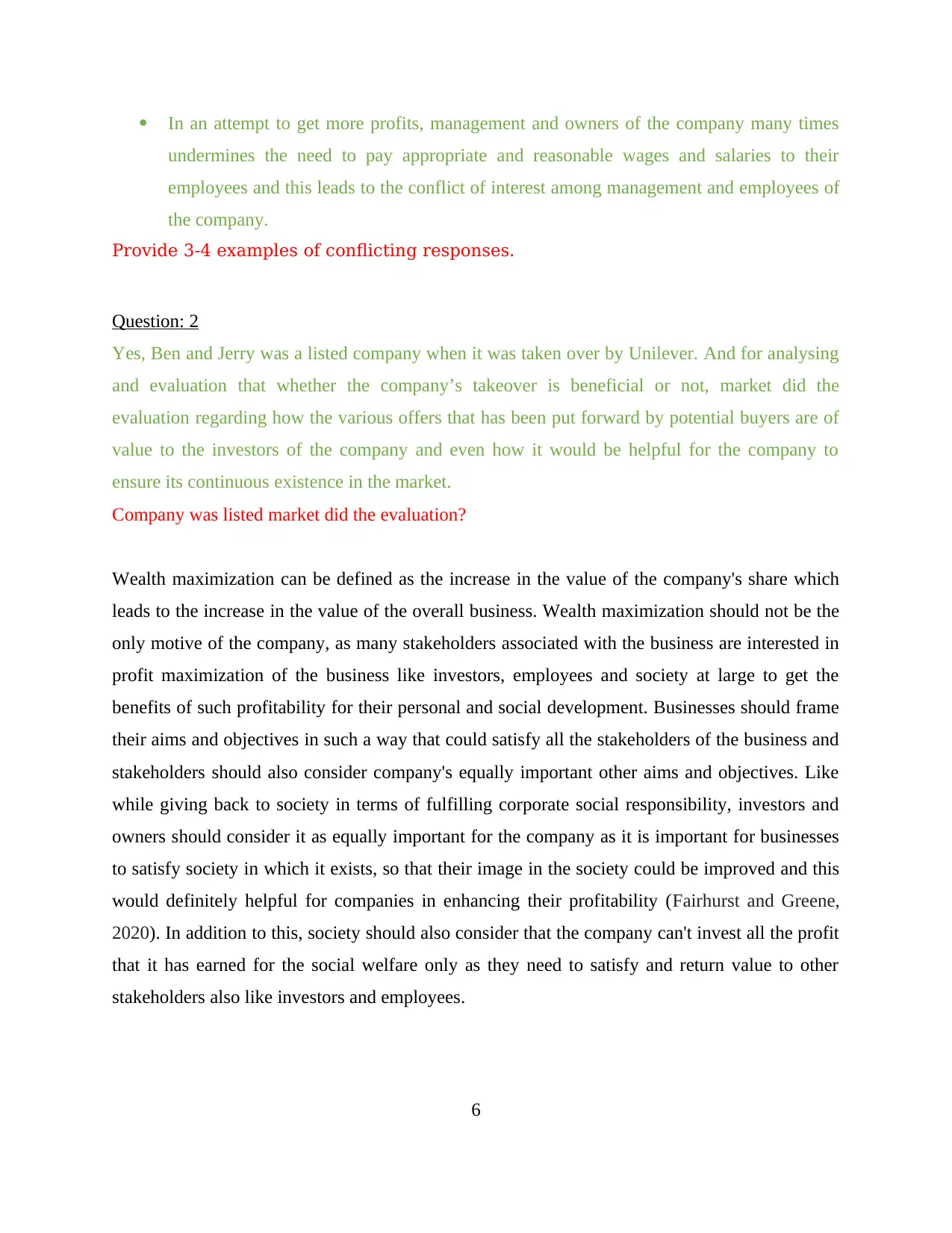
In an attempt to get more profits, management and owners of the company many times
undermines the need to pay appropriate and reasonable wages and salaries to their
employees and this leads to the conflict of interest among management and employees of
the company.
Provide 3-4 examples of conflicting responses.
Question: 2
Yes, Ben and Jerry was a listed company when it was taken over by Unilever. And for analysing
and evaluation that whether the company’s takeover is beneficial or not, market did the
evaluation regarding how the various offers that has been put forward by potential buyers are of
value to the investors of the company and even how it would be helpful for the company to
ensure its continuous existence in the market.
Company was listed market did the evaluation?
Wealth maximization can be defined as the increase in the value of the company's share which
leads to the increase in the value of the overall business. Wealth maximization should not be the
only motive of the company, as many stakeholders associated with the business are interested in
profit maximization of the business like investors, employees and society at large to get the
benefits of such profitability for their personal and social development. Businesses should frame
their aims and objectives in such a way that could satisfy all the stakeholders of the business and
stakeholders should also consider company's equally important other aims and objectives. Like
while giving back to society in terms of fulfilling corporate social responsibility, investors and
owners should consider it as equally important for the company as it is important for businesses
to satisfy society in which it exists, so that their image in the society could be improved and this
would definitely helpful for companies in enhancing their profitability (Fairhurst and Greene,
2020). In addition to this, society should also consider that the company can't invest all the profit
that it has earned for the social welfare only as they need to satisfy and return value to other
stakeholders also like investors and employees.
6
undermines the need to pay appropriate and reasonable wages and salaries to their
employees and this leads to the conflict of interest among management and employees of
the company.
Provide 3-4 examples of conflicting responses.
Question: 2
Yes, Ben and Jerry was a listed company when it was taken over by Unilever. And for analysing
and evaluation that whether the company’s takeover is beneficial or not, market did the
evaluation regarding how the various offers that has been put forward by potential buyers are of
value to the investors of the company and even how it would be helpful for the company to
ensure its continuous existence in the market.
Company was listed market did the evaluation?
Wealth maximization can be defined as the increase in the value of the company's share which
leads to the increase in the value of the overall business. Wealth maximization should not be the
only motive of the company, as many stakeholders associated with the business are interested in
profit maximization of the business like investors, employees and society at large to get the
benefits of such profitability for their personal and social development. Businesses should frame
their aims and objectives in such a way that could satisfy all the stakeholders of the business and
stakeholders should also consider company's equally important other aims and objectives. Like
while giving back to society in terms of fulfilling corporate social responsibility, investors and
owners should consider it as equally important for the company as it is important for businesses
to satisfy society in which it exists, so that their image in the society could be improved and this
would definitely helpful for companies in enhancing their profitability (Fairhurst and Greene,
2020). In addition to this, society should also consider that the company can't invest all the profit
that it has earned for the social welfare only as they need to satisfy and return value to other
stakeholders also like investors and employees.
6
⊘ This is a preview!⊘
Do you want full access?
Subscribe today to unlock all pages.

Trusted by 1+ million students worldwide
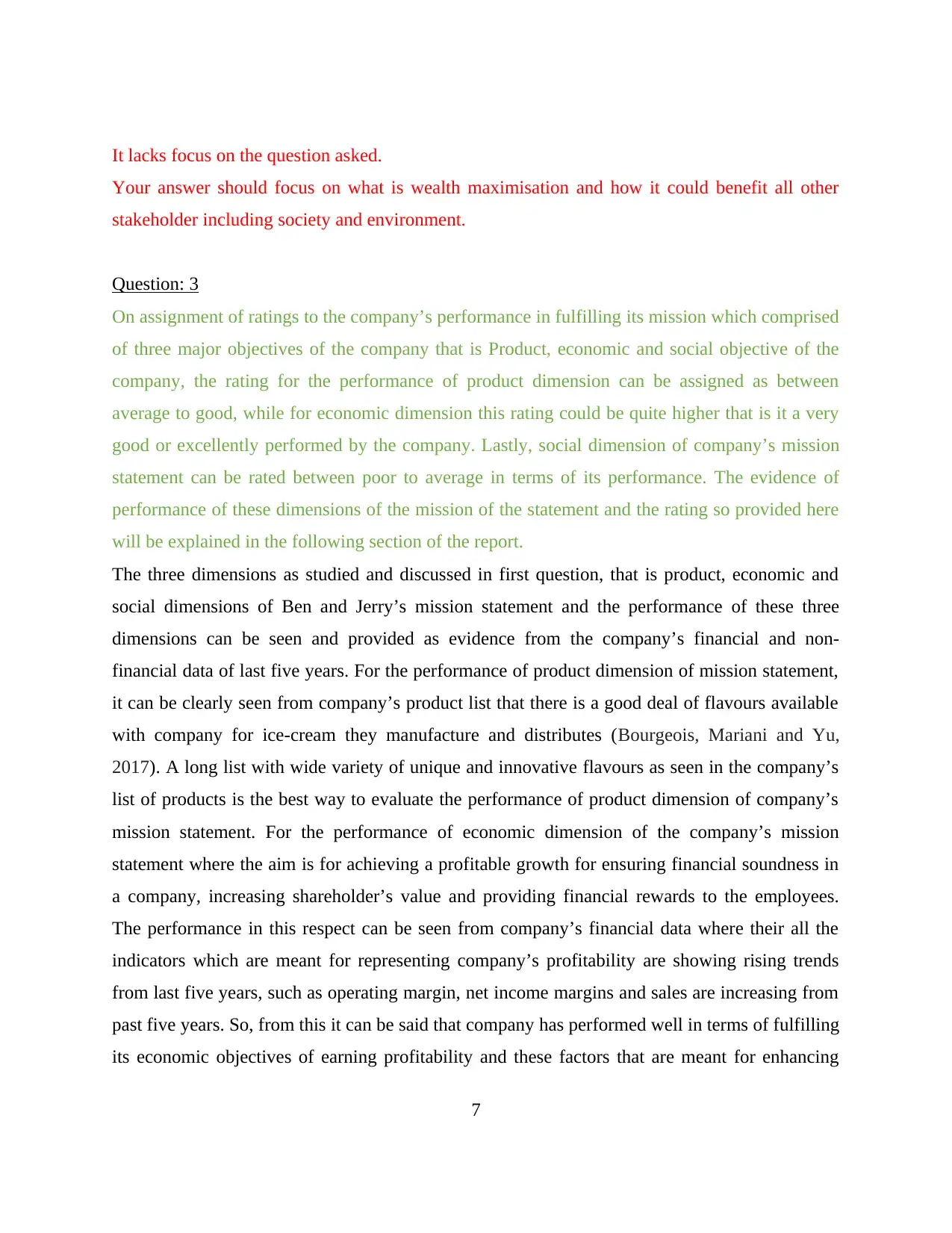
It lacks focus on the question asked.
Your answer should focus on what is wealth maximisation and how it could benefit all other
stakeholder including society and environment.
Question: 3
On assignment of ratings to the company’s performance in fulfilling its mission which comprised
of three major objectives of the company that is Product, economic and social objective of the
company, the rating for the performance of product dimension can be assigned as between
average to good, while for economic dimension this rating could be quite higher that is it a very
good or excellently performed by the company. Lastly, social dimension of company’s mission
statement can be rated between poor to average in terms of its performance. The evidence of
performance of these dimensions of the mission of the statement and the rating so provided here
will be explained in the following section of the report.
The three dimensions as studied and discussed in first question, that is product, economic and
social dimensions of Ben and Jerry’s mission statement and the performance of these three
dimensions can be seen and provided as evidence from the company’s financial and non-
financial data of last five years. For the performance of product dimension of mission statement,
it can be clearly seen from company’s product list that there is a good deal of flavours available
with company for ice-cream they manufacture and distributes (Bourgeois, Mariani and Yu,
2017). A long list with wide variety of unique and innovative flavours as seen in the company’s
list of products is the best way to evaluate the performance of product dimension of company’s
mission statement. For the performance of economic dimension of the company’s mission
statement where the aim is for achieving a profitable growth for ensuring financial soundness in
a company, increasing shareholder’s value and providing financial rewards to the employees.
The performance in this respect can be seen from company’s financial data where their all the
indicators which are meant for representing company’s profitability are showing rising trends
from last five years, such as operating margin, net income margins and sales are increasing from
past five years. So, from this it can be said that company has performed well in terms of fulfilling
its economic objectives of earning profitability and these factors that are meant for enhancing
7
Your answer should focus on what is wealth maximisation and how it could benefit all other
stakeholder including society and environment.
Question: 3
On assignment of ratings to the company’s performance in fulfilling its mission which comprised
of three major objectives of the company that is Product, economic and social objective of the
company, the rating for the performance of product dimension can be assigned as between
average to good, while for economic dimension this rating could be quite higher that is it a very
good or excellently performed by the company. Lastly, social dimension of company’s mission
statement can be rated between poor to average in terms of its performance. The evidence of
performance of these dimensions of the mission of the statement and the rating so provided here
will be explained in the following section of the report.
The three dimensions as studied and discussed in first question, that is product, economic and
social dimensions of Ben and Jerry’s mission statement and the performance of these three
dimensions can be seen and provided as evidence from the company’s financial and non-
financial data of last five years. For the performance of product dimension of mission statement,
it can be clearly seen from company’s product list that there is a good deal of flavours available
with company for ice-cream they manufacture and distributes (Bourgeois, Mariani and Yu,
2017). A long list with wide variety of unique and innovative flavours as seen in the company’s
list of products is the best way to evaluate the performance of product dimension of company’s
mission statement. For the performance of economic dimension of the company’s mission
statement where the aim is for achieving a profitable growth for ensuring financial soundness in
a company, increasing shareholder’s value and providing financial rewards to the employees.
The performance in this respect can be seen from company’s financial data where their all the
indicators which are meant for representing company’s profitability are showing rising trends
from last five years, such as operating margin, net income margins and sales are increasing from
past five years. So, from this it can be said that company has performed well in terms of fulfilling
its economic objectives of earning profitability and these factors that are meant for enhancing
7
Paraphrase This Document
Need a fresh take? Get an instant paraphrase of this document with our AI Paraphraser
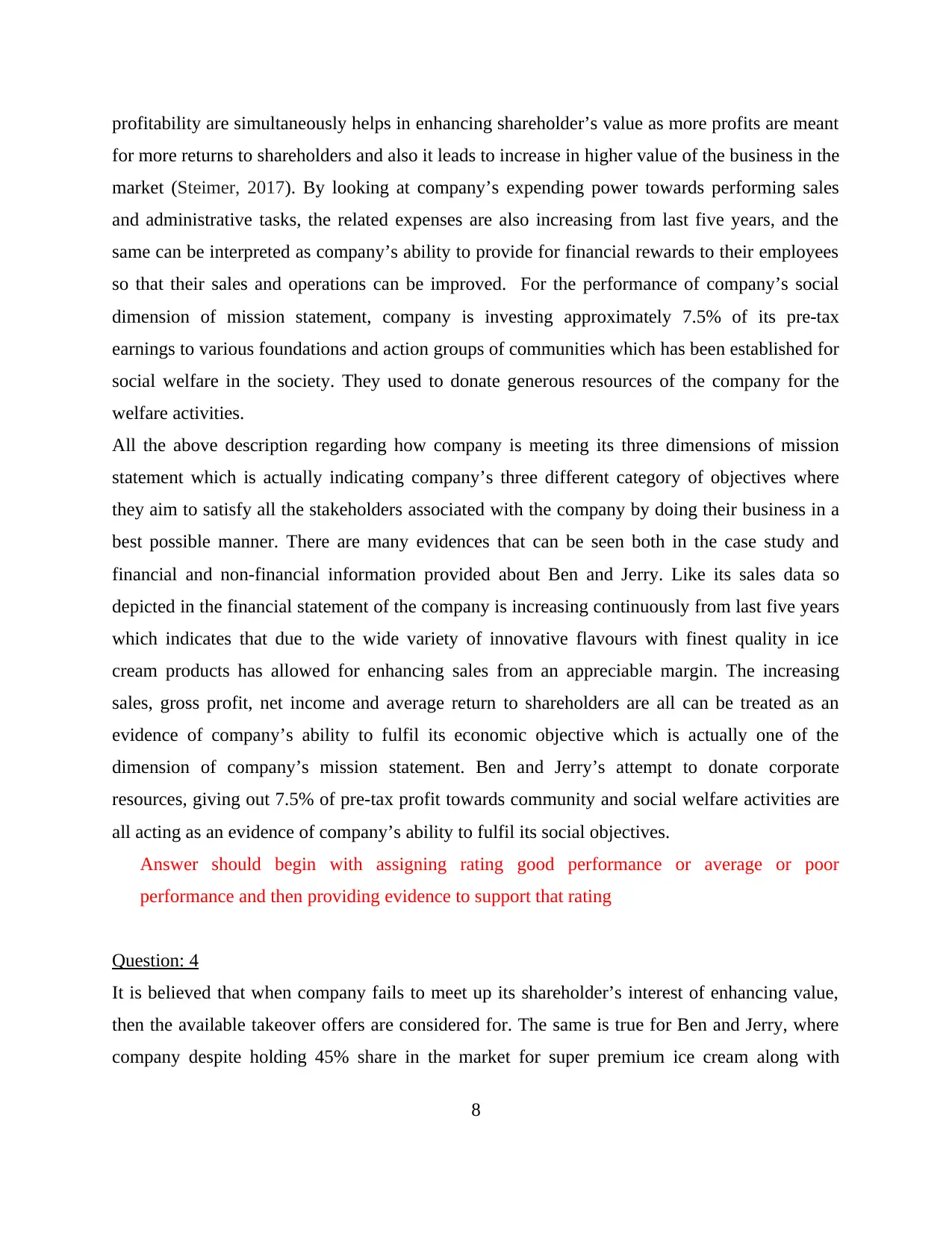
profitability are simultaneously helps in enhancing shareholder’s value as more profits are meant
for more returns to shareholders and also it leads to increase in higher value of the business in the
market (Steimer, 2017). By looking at company’s expending power towards performing sales
and administrative tasks, the related expenses are also increasing from last five years, and the
same can be interpreted as company’s ability to provide for financial rewards to their employees
so that their sales and operations can be improved. For the performance of company’s social
dimension of mission statement, company is investing approximately 7.5% of its pre-tax
earnings to various foundations and action groups of communities which has been established for
social welfare in the society. They used to donate generous resources of the company for the
welfare activities.
All the above description regarding how company is meeting its three dimensions of mission
statement which is actually indicating company’s three different category of objectives where
they aim to satisfy all the stakeholders associated with the company by doing their business in a
best possible manner. There are many evidences that can be seen both in the case study and
financial and non-financial information provided about Ben and Jerry. Like its sales data so
depicted in the financial statement of the company is increasing continuously from last five years
which indicates that due to the wide variety of innovative flavours with finest quality in ice
cream products has allowed for enhancing sales from an appreciable margin. The increasing
sales, gross profit, net income and average return to shareholders are all can be treated as an
evidence of company’s ability to fulfil its economic objective which is actually one of the
dimension of company’s mission statement. Ben and Jerry’s attempt to donate corporate
resources, giving out 7.5% of pre-tax profit towards community and social welfare activities are
all acting as an evidence of company’s ability to fulfil its social objectives.
Answer should begin with assigning rating good performance or average or poor
performance and then providing evidence to support that rating
Question: 4
It is believed that when company fails to meet up its shareholder’s interest of enhancing value,
then the available takeover offers are considered for. The same is true for Ben and Jerry, where
company despite holding 45% share in the market for super premium ice cream along with
8
for more returns to shareholders and also it leads to increase in higher value of the business in the
market (Steimer, 2017). By looking at company’s expending power towards performing sales
and administrative tasks, the related expenses are also increasing from last five years, and the
same can be interpreted as company’s ability to provide for financial rewards to their employees
so that their sales and operations can be improved. For the performance of company’s social
dimension of mission statement, company is investing approximately 7.5% of its pre-tax
earnings to various foundations and action groups of communities which has been established for
social welfare in the society. They used to donate generous resources of the company for the
welfare activities.
All the above description regarding how company is meeting its three dimensions of mission
statement which is actually indicating company’s three different category of objectives where
they aim to satisfy all the stakeholders associated with the company by doing their business in a
best possible manner. There are many evidences that can be seen both in the case study and
financial and non-financial information provided about Ben and Jerry. Like its sales data so
depicted in the financial statement of the company is increasing continuously from last five years
which indicates that due to the wide variety of innovative flavours with finest quality in ice
cream products has allowed for enhancing sales from an appreciable margin. The increasing
sales, gross profit, net income and average return to shareholders are all can be treated as an
evidence of company’s ability to fulfil its economic objective which is actually one of the
dimension of company’s mission statement. Ben and Jerry’s attempt to donate corporate
resources, giving out 7.5% of pre-tax profit towards community and social welfare activities are
all acting as an evidence of company’s ability to fulfil its social objectives.
Answer should begin with assigning rating good performance or average or poor
performance and then providing evidence to support that rating
Question: 4
It is believed that when company fails to meet up its shareholder’s interest of enhancing value,
then the available takeover offers are considered for. The same is true for Ben and Jerry, where
company despite holding 45% share in the market for super premium ice cream along with
8
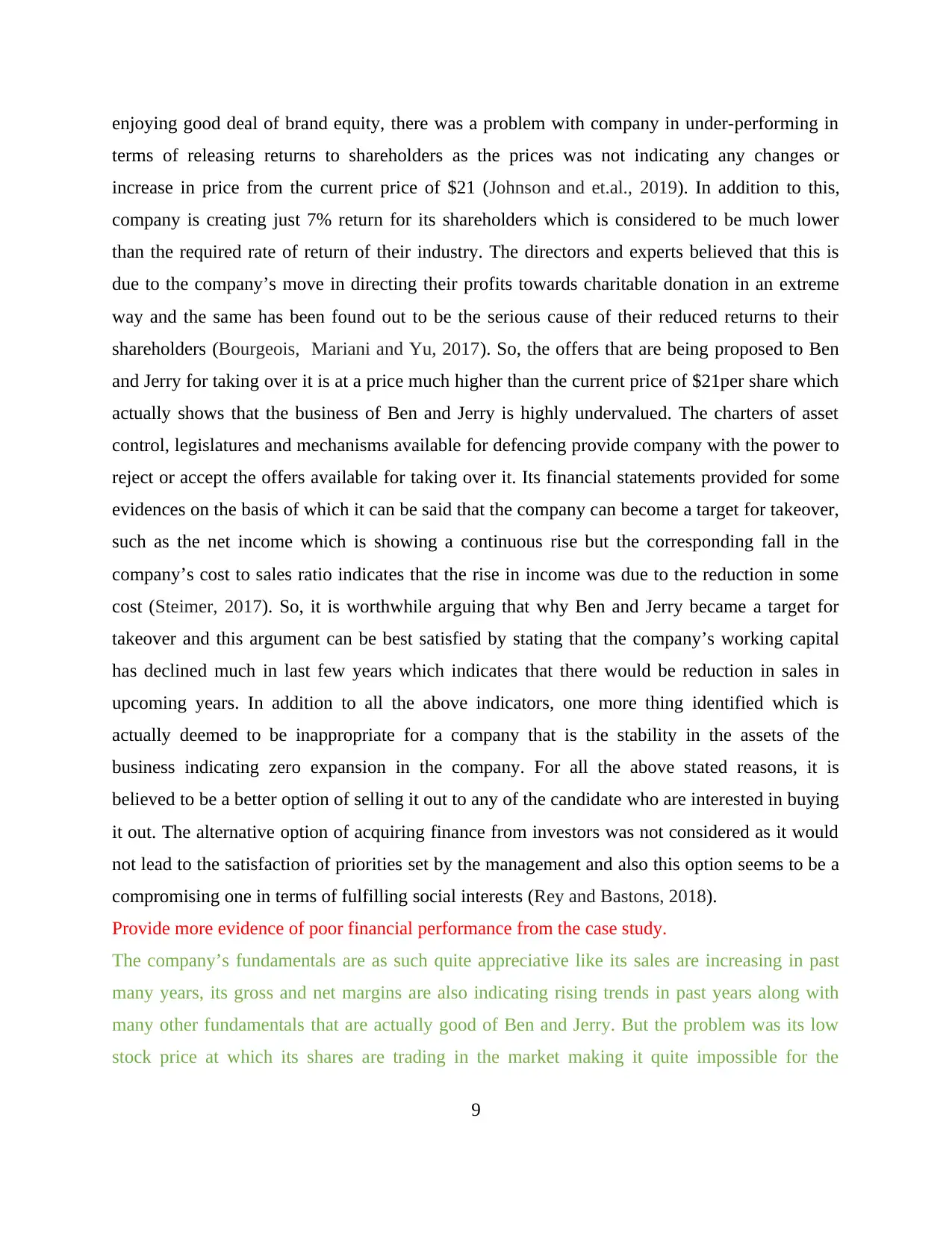
enjoying good deal of brand equity, there was a problem with company in under-performing in
terms of releasing returns to shareholders as the prices was not indicating any changes or
increase in price from the current price of $21 (Johnson and et.al., 2019). In addition to this,
company is creating just 7% return for its shareholders which is considered to be much lower
than the required rate of return of their industry. The directors and experts believed that this is
due to the company’s move in directing their profits towards charitable donation in an extreme
way and the same has been found out to be the serious cause of their reduced returns to their
shareholders (Bourgeois, Mariani and Yu, 2017). So, the offers that are being proposed to Ben
and Jerry for taking over it is at a price much higher than the current price of $21per share which
actually shows that the business of Ben and Jerry is highly undervalued. The charters of asset
control, legislatures and mechanisms available for defencing provide company with the power to
reject or accept the offers available for taking over it. Its financial statements provided for some
evidences on the basis of which it can be said that the company can become a target for takeover,
such as the net income which is showing a continuous rise but the corresponding fall in the
company’s cost to sales ratio indicates that the rise in income was due to the reduction in some
cost (Steimer, 2017). So, it is worthwhile arguing that why Ben and Jerry became a target for
takeover and this argument can be best satisfied by stating that the company’s working capital
has declined much in last few years which indicates that there would be reduction in sales in
upcoming years. In addition to all the above indicators, one more thing identified which is
actually deemed to be inappropriate for a company that is the stability in the assets of the
business indicating zero expansion in the company. For all the above stated reasons, it is
believed to be a better option of selling it out to any of the candidate who are interested in buying
it out. The alternative option of acquiring finance from investors was not considered as it would
not lead to the satisfaction of priorities set by the management and also this option seems to be a
compromising one in terms of fulfilling social interests (Rey and Bastons, 2018).
Provide more evidence of poor financial performance from the case study.
The company’s fundamentals are as such quite appreciative like its sales are increasing in past
many years, its gross and net margins are also indicating rising trends in past years along with
many other fundamentals that are actually good of Ben and Jerry. But the problem was its low
stock price at which its shares are trading in the market making it quite impossible for the
9
terms of releasing returns to shareholders as the prices was not indicating any changes or
increase in price from the current price of $21 (Johnson and et.al., 2019). In addition to this,
company is creating just 7% return for its shareholders which is considered to be much lower
than the required rate of return of their industry. The directors and experts believed that this is
due to the company’s move in directing their profits towards charitable donation in an extreme
way and the same has been found out to be the serious cause of their reduced returns to their
shareholders (Bourgeois, Mariani and Yu, 2017). So, the offers that are being proposed to Ben
and Jerry for taking over it is at a price much higher than the current price of $21per share which
actually shows that the business of Ben and Jerry is highly undervalued. The charters of asset
control, legislatures and mechanisms available for defencing provide company with the power to
reject or accept the offers available for taking over it. Its financial statements provided for some
evidences on the basis of which it can be said that the company can become a target for takeover,
such as the net income which is showing a continuous rise but the corresponding fall in the
company’s cost to sales ratio indicates that the rise in income was due to the reduction in some
cost (Steimer, 2017). So, it is worthwhile arguing that why Ben and Jerry became a target for
takeover and this argument can be best satisfied by stating that the company’s working capital
has declined much in last few years which indicates that there would be reduction in sales in
upcoming years. In addition to all the above indicators, one more thing identified which is
actually deemed to be inappropriate for a company that is the stability in the assets of the
business indicating zero expansion in the company. For all the above stated reasons, it is
believed to be a better option of selling it out to any of the candidate who are interested in buying
it out. The alternative option of acquiring finance from investors was not considered as it would
not lead to the satisfaction of priorities set by the management and also this option seems to be a
compromising one in terms of fulfilling social interests (Rey and Bastons, 2018).
Provide more evidence of poor financial performance from the case study.
The company’s fundamentals are as such quite appreciative like its sales are increasing in past
many years, its gross and net margins are also indicating rising trends in past years along with
many other fundamentals that are actually good of Ben and Jerry. But the problem was its low
stock price at which its shares are trading in the market making it quite impossible for the
9
⊘ This is a preview!⊘
Do you want full access?
Subscribe today to unlock all pages.

Trusted by 1+ million students worldwide
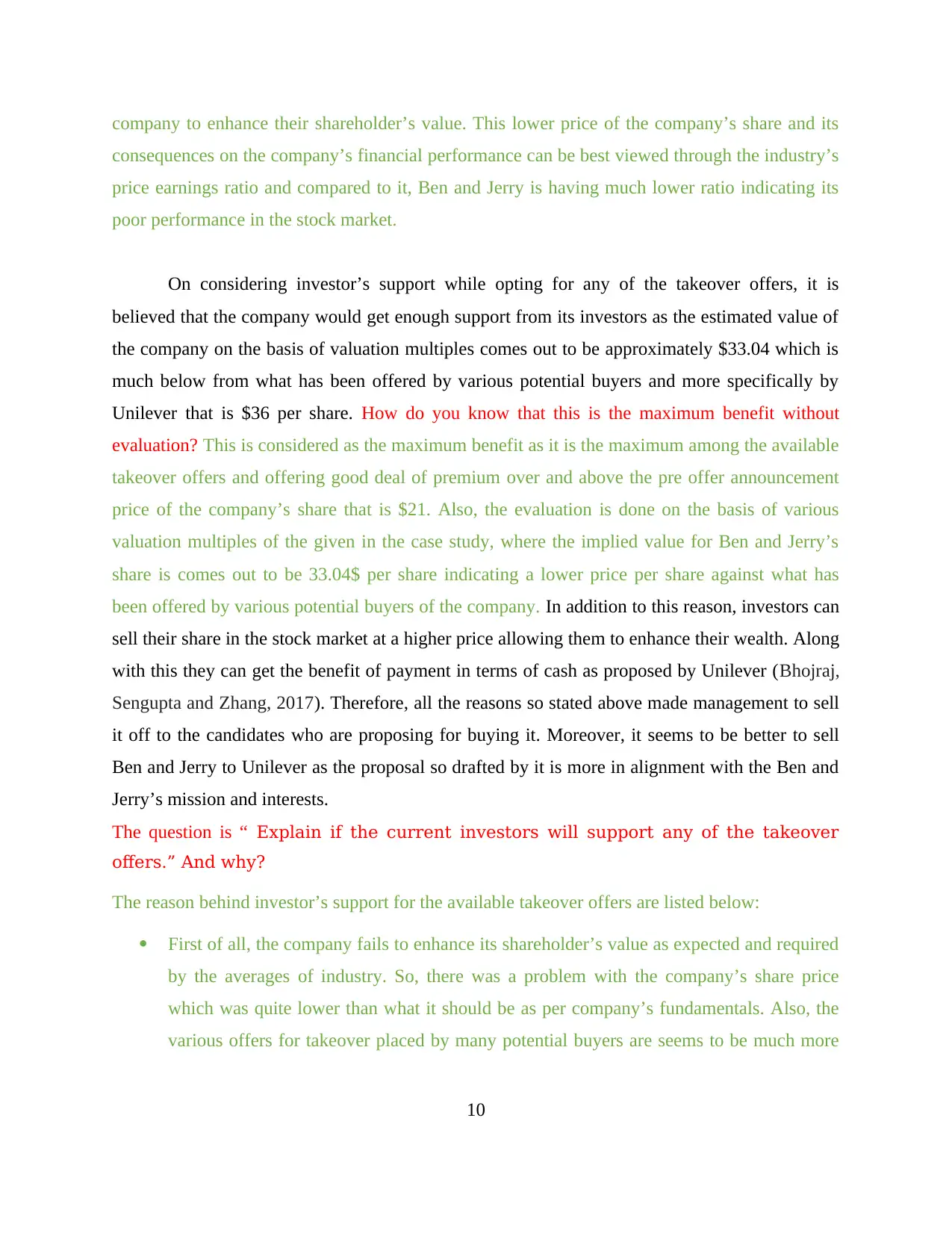
company to enhance their shareholder’s value. This lower price of the company’s share and its
consequences on the company’s financial performance can be best viewed through the industry’s
price earnings ratio and compared to it, Ben and Jerry is having much lower ratio indicating its
poor performance in the stock market.
On considering investor’s support while opting for any of the takeover offers, it is
believed that the company would get enough support from its investors as the estimated value of
the company on the basis of valuation multiples comes out to be approximately $33.04 which is
much below from what has been offered by various potential buyers and more specifically by
Unilever that is $36 per share. How do you know that this is the maximum benefit without
evaluation? This is considered as the maximum benefit as it is the maximum among the available
takeover offers and offering good deal of premium over and above the pre offer announcement
price of the company’s share that is $21. Also, the evaluation is done on the basis of various
valuation multiples of the given in the case study, where the implied value for Ben and Jerry’s
share is comes out to be 33.04$ per share indicating a lower price per share against what has
been offered by various potential buyers of the company. In addition to this reason, investors can
sell their share in the stock market at a higher price allowing them to enhance their wealth. Along
with this they can get the benefit of payment in terms of cash as proposed by Unilever (Bhojraj,
Sengupta and Zhang, 2017). Therefore, all the reasons so stated above made management to sell
it off to the candidates who are proposing for buying it. Moreover, it seems to be better to sell
Ben and Jerry to Unilever as the proposal so drafted by it is more in alignment with the Ben and
Jerry’s mission and interests.
The question is “ Explain if the current investors will support any of the takeover
offers.” And why?
The reason behind investor’s support for the available takeover offers are listed below:
First of all, the company fails to enhance its shareholder’s value as expected and required
by the averages of industry. So, there was a problem with the company’s share price
which was quite lower than what it should be as per company’s fundamentals. Also, the
various offers for takeover placed by many potential buyers are seems to be much more
10
consequences on the company’s financial performance can be best viewed through the industry’s
price earnings ratio and compared to it, Ben and Jerry is having much lower ratio indicating its
poor performance in the stock market.
On considering investor’s support while opting for any of the takeover offers, it is
believed that the company would get enough support from its investors as the estimated value of
the company on the basis of valuation multiples comes out to be approximately $33.04 which is
much below from what has been offered by various potential buyers and more specifically by
Unilever that is $36 per share. How do you know that this is the maximum benefit without
evaluation? This is considered as the maximum benefit as it is the maximum among the available
takeover offers and offering good deal of premium over and above the pre offer announcement
price of the company’s share that is $21. Also, the evaluation is done on the basis of various
valuation multiples of the given in the case study, where the implied value for Ben and Jerry’s
share is comes out to be 33.04$ per share indicating a lower price per share against what has
been offered by various potential buyers of the company. In addition to this reason, investors can
sell their share in the stock market at a higher price allowing them to enhance their wealth. Along
with this they can get the benefit of payment in terms of cash as proposed by Unilever (Bhojraj,
Sengupta and Zhang, 2017). Therefore, all the reasons so stated above made management to sell
it off to the candidates who are proposing for buying it. Moreover, it seems to be better to sell
Ben and Jerry to Unilever as the proposal so drafted by it is more in alignment with the Ben and
Jerry’s mission and interests.
The question is “ Explain if the current investors will support any of the takeover
offers.” And why?
The reason behind investor’s support for the available takeover offers are listed below:
First of all, the company fails to enhance its shareholder’s value as expected and required
by the averages of industry. So, there was a problem with the company’s share price
which was quite lower than what it should be as per company’s fundamentals. Also, the
various offers for takeover placed by many potential buyers are seems to be much more
10
Paraphrase This Document
Need a fresh take? Get an instant paraphrase of this document with our AI Paraphraser
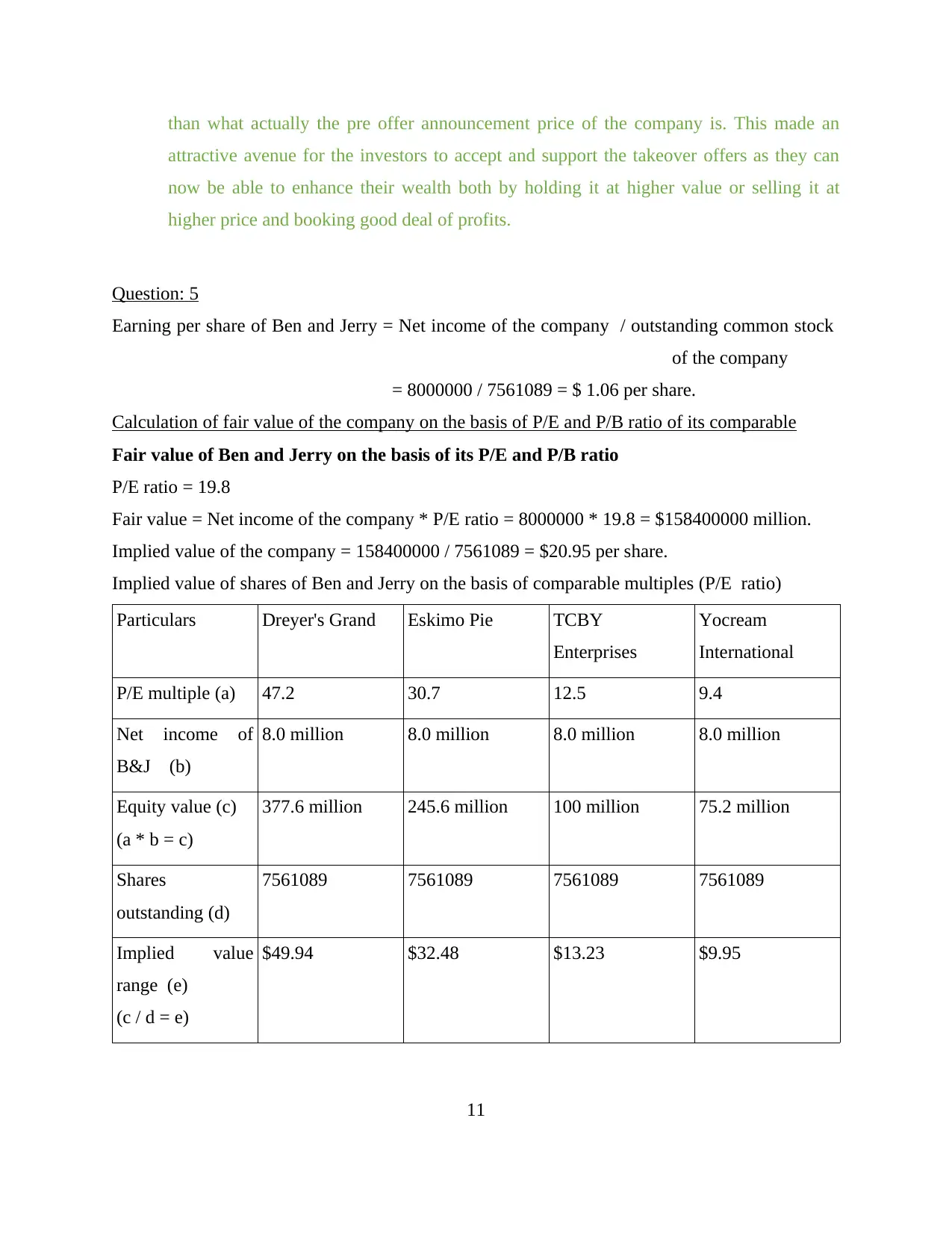
than what actually the pre offer announcement price of the company is. This made an
attractive avenue for the investors to accept and support the takeover offers as they can
now be able to enhance their wealth both by holding it at higher value or selling it at
higher price and booking good deal of profits.
Question: 5
Earning per share of Ben and Jerry = Net income of the company / outstanding common stock
of the company
= 8000000 / 7561089 = $ 1.06 per share.
Calculation of fair value of the company on the basis of P/E and P/B ratio of its comparable
Fair value of Ben and Jerry on the basis of its P/E and P/B ratio
P/E ratio = 19.8
Fair value = Net income of the company * P/E ratio = 8000000 * 19.8 = $158400000 million.
Implied value of the company = 158400000 / 7561089 = $20.95 per share.
Implied value of shares of Ben and Jerry on the basis of comparable multiples (P/E ratio)
Particulars Dreyer's Grand Eskimo Pie TCBY
Enterprises
Yocream
International
P/E multiple (a) 47.2 30.7 12.5 9.4
Net income of
B&J (b)
8.0 million 8.0 million 8.0 million 8.0 million
Equity value (c)
(a * b = c)
377.6 million 245.6 million 100 million 75.2 million
Shares
outstanding (d)
7561089 7561089 7561089 7561089
Implied value
range (e)
(c / d = e)
$49.94 $32.48 $13.23 $9.95
11
attractive avenue for the investors to accept and support the takeover offers as they can
now be able to enhance their wealth both by holding it at higher value or selling it at
higher price and booking good deal of profits.
Question: 5
Earning per share of Ben and Jerry = Net income of the company / outstanding common stock
of the company
= 8000000 / 7561089 = $ 1.06 per share.
Calculation of fair value of the company on the basis of P/E and P/B ratio of its comparable
Fair value of Ben and Jerry on the basis of its P/E and P/B ratio
P/E ratio = 19.8
Fair value = Net income of the company * P/E ratio = 8000000 * 19.8 = $158400000 million.
Implied value of the company = 158400000 / 7561089 = $20.95 per share.
Implied value of shares of Ben and Jerry on the basis of comparable multiples (P/E ratio)
Particulars Dreyer's Grand Eskimo Pie TCBY
Enterprises
Yocream
International
P/E multiple (a) 47.2 30.7 12.5 9.4
Net income of
B&J (b)
8.0 million 8.0 million 8.0 million 8.0 million
Equity value (c)
(a * b = c)
377.6 million 245.6 million 100 million 75.2 million
Shares
outstanding (d)
7561089 7561089 7561089 7561089
Implied value
range (e)
(c / d = e)
$49.94 $32.48 $13.23 $9.95
11
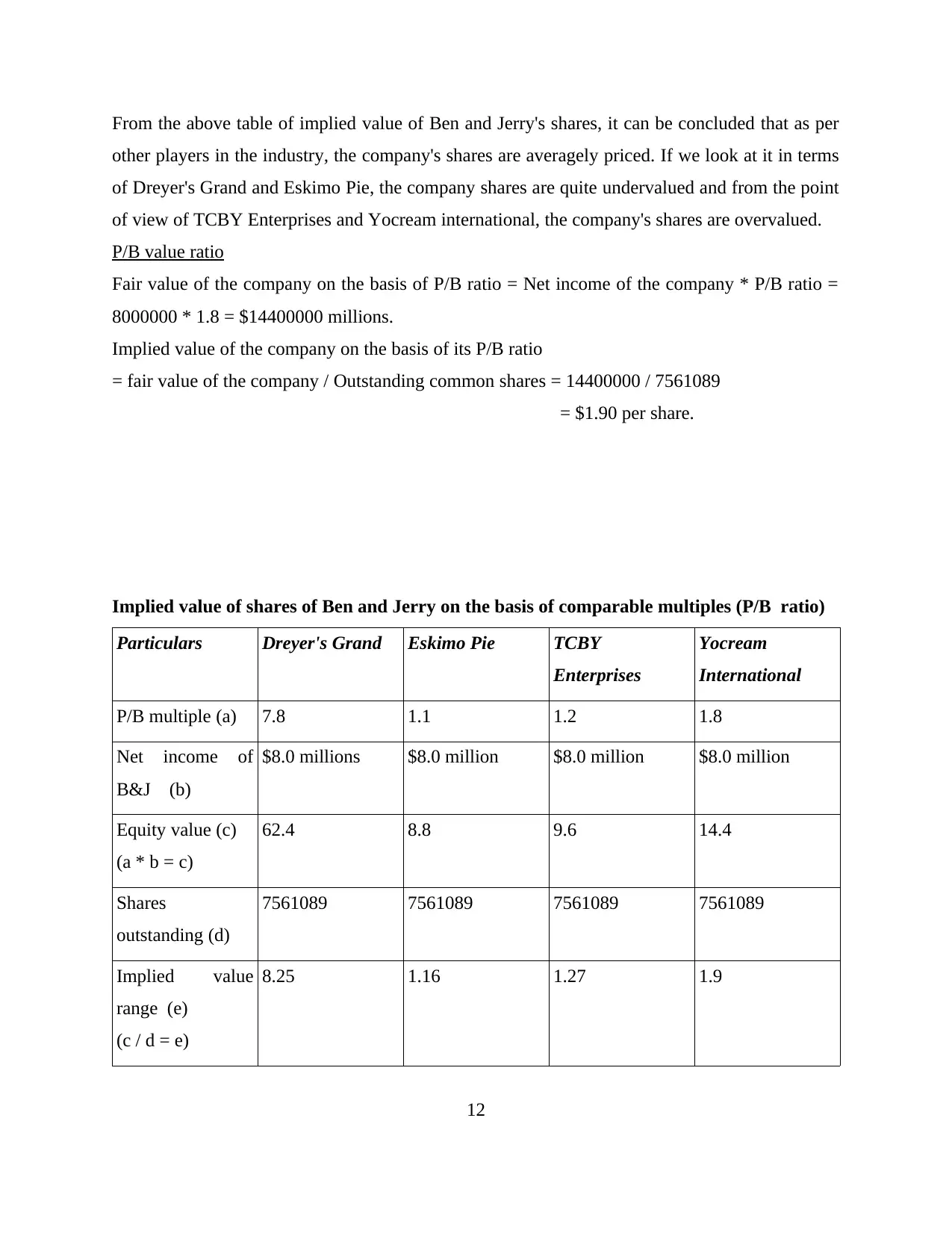
From the above table of implied value of Ben and Jerry's shares, it can be concluded that as per
other players in the industry, the company's shares are averagely priced. If we look at it in terms
of Dreyer's Grand and Eskimo Pie, the company shares are quite undervalued and from the point
of view of TCBY Enterprises and Yocream international, the company's shares are overvalued.
P/B value ratio
Fair value of the company on the basis of P/B ratio = Net income of the company * P/B ratio =
8000000 * 1.8 = $14400000 millions.
Implied value of the company on the basis of its P/B ratio
= fair value of the company / Outstanding common shares = 14400000 / 7561089
= $1.90 per share.
Implied value of shares of Ben and Jerry on the basis of comparable multiples (P/B ratio)
Particulars Dreyer's Grand Eskimo Pie TCBY
Enterprises
Yocream
International
P/B multiple (a) 7.8 1.1 1.2 1.8
Net income of
B&J (b)
$8.0 millions $8.0 million $8.0 million $8.0 million
Equity value (c)
(a * b = c)
62.4 8.8 9.6 14.4
Shares
outstanding (d)
7561089 7561089 7561089 7561089
Implied value
range (e)
(c / d = e)
8.25 1.16 1.27 1.9
12
other players in the industry, the company's shares are averagely priced. If we look at it in terms
of Dreyer's Grand and Eskimo Pie, the company shares are quite undervalued and from the point
of view of TCBY Enterprises and Yocream international, the company's shares are overvalued.
P/B value ratio
Fair value of the company on the basis of P/B ratio = Net income of the company * P/B ratio =
8000000 * 1.8 = $14400000 millions.
Implied value of the company on the basis of its P/B ratio
= fair value of the company / Outstanding common shares = 14400000 / 7561089
= $1.90 per share.
Implied value of shares of Ben and Jerry on the basis of comparable multiples (P/B ratio)
Particulars Dreyer's Grand Eskimo Pie TCBY
Enterprises
Yocream
International
P/B multiple (a) 7.8 1.1 1.2 1.8
Net income of
B&J (b)
$8.0 millions $8.0 million $8.0 million $8.0 million
Equity value (c)
(a * b = c)
62.4 8.8 9.6 14.4
Shares
outstanding (d)
7561089 7561089 7561089 7561089
Implied value
range (e)
(c / d = e)
8.25 1.16 1.27 1.9
12
⊘ This is a preview!⊘
Do you want full access?
Subscribe today to unlock all pages.

Trusted by 1+ million students worldwide
1 out of 19
Related Documents
Your All-in-One AI-Powered Toolkit for Academic Success.
+13062052269
info@desklib.com
Available 24*7 on WhatsApp / Email
![[object Object]](/_next/static/media/star-bottom.7253800d.svg)
Unlock your academic potential
Copyright © 2020–2025 A2Z Services. All Rights Reserved. Developed and managed by ZUCOL.





